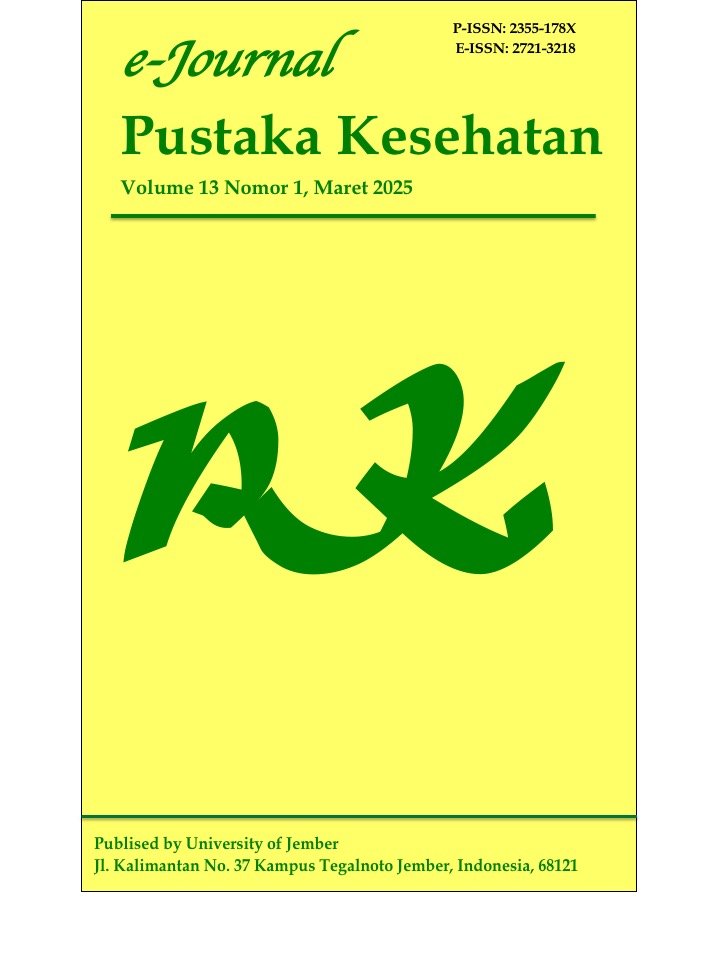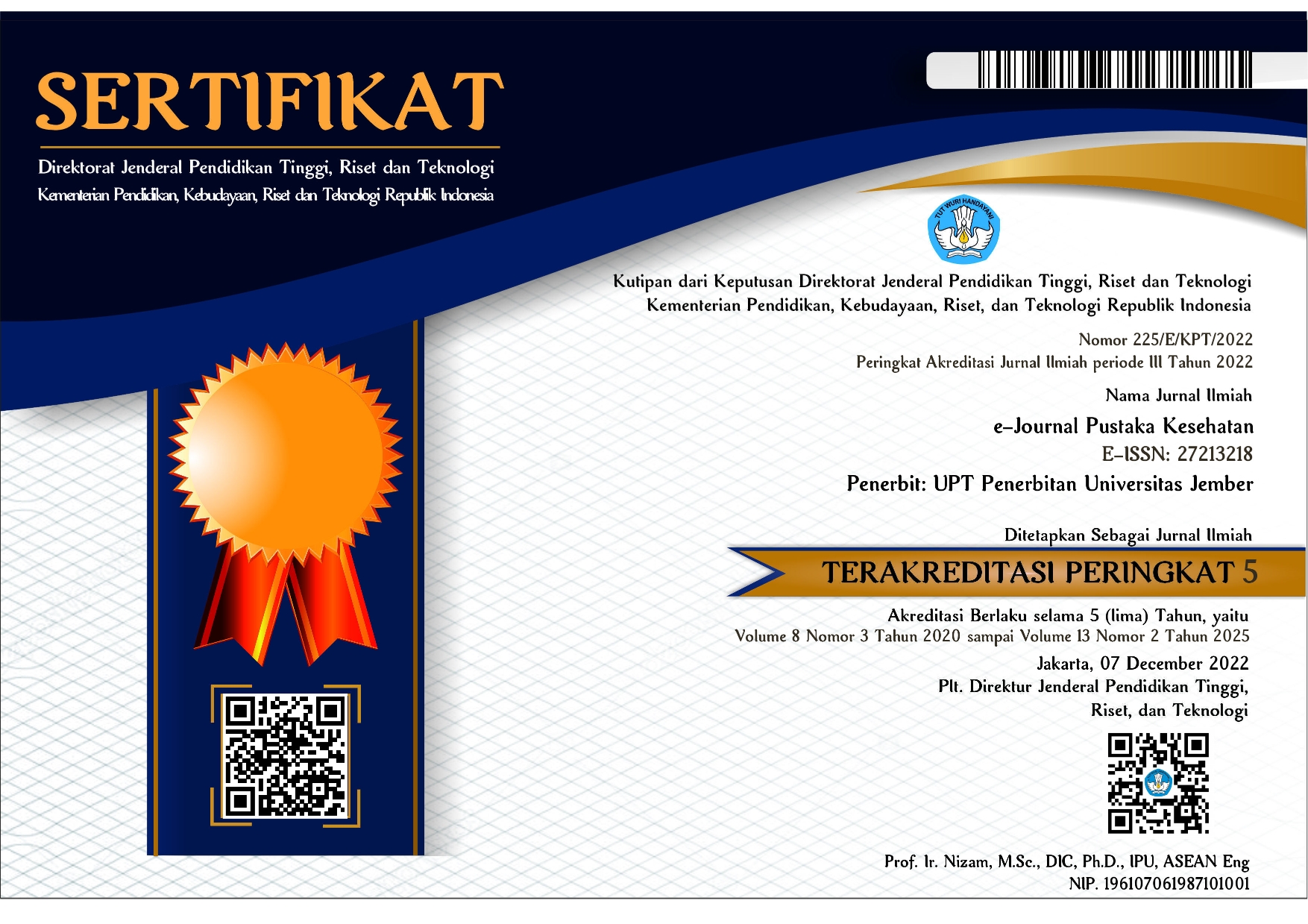Faktor yang Berhubungan dengan Pemilihan Metode Kontrasepsi Jangka Panjang (MKJP) pada Wanita Pasangan Usia Subur di Wilayah Kerja Puskesmas Semboro, Jember
Keywords:
contraception, , long-term contraception method, women of reproductive ageAbstract
The inappropriate use of contraception methods contributes to an increase of population, particularly in the case of low utilization of long-term contraceptive method such as long-acting reversible contraceptives (LARCs)). Semboro Sub-district had the second lowest active LARCs usage in 2021, with 10,290 users (42%), following Pakusari Sub-district. Factors influencing the selection of LARCs in the Semboro Primary Health Care Work Area include predisposing, enabling, and reinforcing factors. The objective of this study was to analyze factors related to the selection of LARC among women of reproductive age in the Semboro Primary Health Care Work Area, Jember District. The research employed a quantitative method with a sample of 141 women of reproductive age. Independent variables included age, education, knowledge, parity, and cost, while the dependent variable was the selection of LARC. Results indicated a correlation between age, knowledge, cost, and spousal support with LARC selection, while education and parity showed no significant correlation. Researchers suggested that the community actively seek information about suitable contraceptives and that spouses be supported in choosing the appropriate contraceptive method.
Downloads
References
[1] Kemenkes. Buku Profil Kesehatan Indonesia Tahun 2020. Jakarta: Kementerian Kesehatan RI; 2021.
[2] Suryanti Y. Factors Related to the Use of Long-Term Contraception Method in Fertilizer Age Women. Jambura J Heal Sci Res [Internet]. 2020;1(1). Available from: http://ejurnal.ung.ac.id/index.php/jjhsr
[3] Handayani SR. Dokumentasi Kebidanan: Bahan Ajar Kebidanan. Jakarta: Penerbit Eureka; 2019.
[4] BKKBN. Peraturan Kepala Badan Kependudukan Dan Keluarga Berencana Nasional Nomor 24 Tentang Pelayanan Keluarga Berencana Pasca Persalinan Dan Pasca Keguguran. Jakarta: BKKBN; 2017.
[5] Kemenkes. Profil Kesehatan Kabupaten Jember 2021. Jember: Dinas Kesehatan Kabupaten Jember; 2020.
[6] Aryati S, Widyastuti D. Faktor-Faktor Yang Mempengaruhi Pemilihan Metode Kontrasepsi (Kasus di Kecamatan Seberang Ulu I Kota Palembang). Maj Geogr Indones. 2019;33(1):75–85.
[7] Triyanto L, Indriani D. Faktor Yang Mempengaruhi Penggunaan Jenis Metode Kontrasepsi Jangka Panjang (MKJP) Pada Wanita Menikah Usia Subur di Provinsi Jawa Timur. Indones J Public Heal. 2018;13(2):244–55.
[8] Budiarti, Nuryani, Hidayat. Determinan Penggunaan Metode Kontrasepsi Jangka Panjang (MKJP) pada Akseptor KB. J Kesehat [Internet]. 2020;8(2):220–4. Available from: https://www.researchgate.net/publication/323982275
[9] Yustin F. Faktor-Faktor yang Berhubungan dengan Pemilihan Metode Kontrasepsi Jangka Panjang (MKJP) pada Pasangan Usia Subur (PUS) di Puskesmas Gayamsari Kota Semarang 2020 Prodi Sarjana Terapan Kebidanan Semarang. Tidak Dipublikasikan. Poltekkes Kemenkes Semarang; 2020.
[10] Haryati E. Hubungan Tingkat Pengetahuan Dengan Penggunaan Metode Kontrasepsi Jangka Panjang (Mkjp) Di Uptd Puskesmas Lompoe Kota Parepare Tahun 2020. 2020;
[11] Rismawati R, Asriwati A, Sibero T, Hadi J. Faktor Yang Mempengaruhi Wanita PUS Terhadap Pemilihan Metode Kontrasepsi Jangka Panjang (MKJP) Di Puskesmas Mayor Umar Damanik Kecamatan Tanjungbalai Selatan Kota Tanjungbalai. Media Publ Promosi Kesehat Indones. 2020;3(2):100–5.
[12] Supri M. Faktor Yang Berhubungan dengan Kejadian Penghentian Alat Kontrasepsi di Indonesia (Analisis Survei Kinerja Dan Akuntabilitas Program KKBPK Tahun 2019). Universitas Hasanuddin; 2021.
[13] Atikaturrosida. Alasan Pasangan Usia Subur (PUS) Lebih Memilih Alat Kontrasepsi Non-MKJP Dibanding MKJP. J Penelit Perawat Prof. 2023;5(4).
[14] Sudirman, Herdiana. Hubungan Dukungan Suami dengan Pemilihan Metode Kontrasepsi pada Pasangan Usia Subur. J Nurs Pract Educ. 2020;1(1):21–9.
[15] Safitri. Pengetahuan Ibu dan Dukungan Suami berhubungan dengan Pemakaian Metode Kontrasepsi Jangka Panjang (MKJP). J Akad Baiturrahim Jambi. 2021;10(1).
[16] Dewiyanti N. Hubungan umur dan jumlah anak terhadap penggunaan metode kontrasepsi di puskesmas Bulak Banteng Surabaya. edical Technol Public Heal J. 2020;4(1):70–8.
[17] Marita C. Faktor-Faktor yang Berhubungan dengan Penggunaan Alat Kontrasepsi Dalam Rahim di UPTD Puskesmas Lubuk Rukam OKU Tahun 2021. J Ilm Univ Batanghari Jambi. 2022;22(1):62–9.
[18] Rosidah L. Pengaruh Tingkat Pendidikan dan Usia Terhadap Penggunaan Metode Kontrasepsi Jangka Panjang di RT 01/ RW 01 Desa Jatirejo Kecamatan Banyakan Kabupaten Kediri Tahun 2018. J Kebidanan. 2020;9(2):108–14.
[19] Nuraini N, Aisyah S, Indriani PLN. Hubungan Paritas, Biaya dan Pendidikan dengan KB Implant. J Ilm Univ Batanghari Jambi. 2021;21(1):382.
[20] Jasa N. Paritas, Pekerjaan dan Pendidikan Berhubungan dengan Pemilihan Alat Kontrasepsi MKJP Pada Akseptor KB. Sekolah Tinggi Ilmu Kesehatan Panca Bhakti; 2020.
[21] Septalia R, Puspitasari N. Faktor yang Memengaruhi Pemilihan Metode Kontrasepsi. J Biometrika dan Kependud. 2017;5(2):91.
Downloads
Published
Issue
Section
License
Copyright (c) 2025 Andrei Ramani, Nadilla Putri Anjari, Dimas Bagus Cahyaningrat

This work is licensed under a Creative Commons Attribution-ShareAlike 4.0 International License.
e-Journal Pustaka Kesehatan has CC-BY-SA or an equivalent license as the optimal license for the publication, distribution, use, and reuse of scholarly work. Authors who publish with this journal retain copyright and grant the journal right of first publication with the work simultaneously licensed under a Creative Commons Attribution-ShareAlike 4.0 International License that allows others to share the work with an acknowledgment of the work's authorship and initial publication in this journal.







